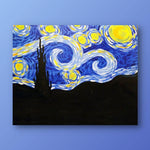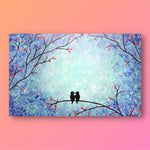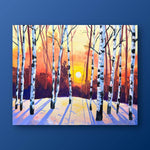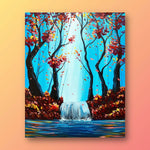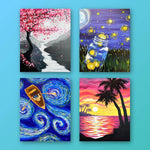8 Creative Art and Painting Activities for Adults
Regardless of your skill level as an artist, being creative — and specifically painting as an adult — can be relaxing and enjoyable. Science supports this notion, too, with tons of studies showing the effectiveness of art therapy. Creativity has also been found to increase happiness, reduce your risk of dementia, improve overall mental health, boost your immune system, make you smarter, boost self-esteem, and more.
There are so many ways to exercise your creative muscles as an adult, but below we’re going to cover different types of painting activities including virtual painting classes, watercolor, and painting on various mediums.
1) Join a Virtual Painting Class
Whether you’re a seasoned painter or just picking up a paintbrush for the first time, a virtual painting class can be an extremely rewarding and fun way to enhance your creativity. Participating in a virtual art class with Painting to Gogh gives you the opportunity to paint classics like Van Gogh’s Starry Night.
The great thing about Painting to Gogh is that you can get all your painting supplies shipped to your doorstep, along with access to a video tutorial with step-by-step instructions led by a professional artist.
Here are all of the beautiful options available through Painting to Gogh.
This could also be a great option if you want to paint with a friend or significant other — you could even throw a paint party. If this sounds interesting to you, check out our detailed guide on how to host your own paint party.
2) Use Stencils To Create Layered Art
Another craft project that incorporates paint is stencil art. This type of art allows for a ton of creative expression, while still providing a comfort level for all skill levels. You can find stencils at any local craft or paint store that would be perfect for this type of project — you may even have some old stencils around your house.
Whatever the case may be, gather up some stencils, a backdrop for your art (like paper or canvas), paint, and a sponge or paintbrush. When it comes to paint, we recommend using acrylic because it dries quickly and allows for easier cleanup when you’re finished.
Once you have all your supplies collected, you can get started by placing your stencil on your surface and either sponge-painting in the stencil, or brushing your paint in the stencil. You can use the same stencil on different parts of your medium, but be sure to wipe off the stencil in between colors.
When you have your first layer created, you’ll want to make sure it’s dry before adding additional layers. So, while you wait, you can plan out how you envision the rest of your piece to look. Combine different shapes on top of one another, or make use of complementary colors — these are just a few strategies to help get your creative juices flowing. You can even consult a color wheel for additional insight.
After you add all your layers of stencils, let it dry completely and then you’ll be able to admire your fine artwork! Stencil collages can also be used as backgrounds for additional art activities like scrapbooks and doodling.
3) Experiment With Watercolors
Watercolor is another type of painting technique you can explore. Watercolor is different from standard acrylic or oil paint because it contains a colored pigment and water-soluble binder, which means you have to add water to the paint in order to spread it around on your medium.
Watercolor painting may seem intimidating because it can be difficult to control, therefore, leading to unpredictability in your creations. However, working with watercolors can be a great practice in leaning into uncertainty and going with the flow. Because of the highly blendable, yet bleedable nature of watercolors, you can create a wide spectrum of colors and depth.
In addition to understanding what you’re getting into with watercolors, we recommend a few other tips if you’re new to watercolors:
- Basic colors are all you need: Because the depth of each watercolor varies so much depending on the amount of water you mix with it, you don’t need to go overboard with colors. Keep it simple with primary colors that you can mix and blend with one another.
- Always use a palette: Watercolors are watery, so be sure to blend your colors separately from your canvas. You can purchase a palette at your local art store, or use an old plate — just make sure it’s non-porous.
- Use watercolor paper: Using watercolors on regular paper will not lead to a great result, as the paper will warp. To avoid this, you’ll need paper specifically designed for use with watercolor.
- Embrace imperfection: We know watercolors can be unpredictable, so don’t be too disappointed if your watercolor painting starts going in a direction you didn’t plan — it’s all part of the creative process!
4) Make a Mess With Splatter Painting
Splatter painting may sound like a kids’ activity, but it can be just as fun for adults. In fact, artist Jackson Pollock was famous for his splatter paintings. The good news is that there is no wrong way to do splatter painting, so if you’re into spontaneity and abstraction, this style could be perfect for you.
Basically, splatter painting — also known as drip painting — is splattering paint onto a surface. You can use a canvas, a piece of paper, a wall, a piece of clothing, or even the floor.
You can use any type of paint for splatter painting, though watercolors and gouache paint will give you a softer look than acrylic paint, for example. If you’re splatter painting a wall or floor, latex wall paint can work great. Splatter painting can also be great for printmaking.
To create the splatters, you can also use whatever you want. A common approach is using brushes of various sizes and dipping them in various colors and flinging the brush toward your surface. Another method is flicking the bristles of your brush in the direction of your surface to create splatters.
Here’s some great inspiration for your next project:

Source: https://www.broogly.com/project/splatter-paintings-pollock-style



5) Get Creative With Sidewalk Painting
Sidewalk painting can be another medium that is a bit out of the norm, but is a great project for those who enjoy spending time outdoors and are looking for a way to be creative in nature. Sidewalk painting can be done to create a celebratory sign, or just as a way to express creativity on a new surface.
The biggest thing to keep in mind if you want to dabble in sidewalk painting is that you’ll need to use paint specifically for sidewalks — you don’t want to use traditional acrylic or oil-based paint, as those will not wash off and can be toxic to the environment. Luckily, sidewalk paint can be made easily at home.
To make sidewalk paint, all you need is cornstarch, water, and food coloring. You can use equal parts cornstarch and water, followed by several dashes of food coloring. To make multiple colors at once, we recommend using plastic bowls or a muffin tin to mix each color.
When it comes to brushes, you’ll want to use larger paintbrushes than you would for painting on a small canvas or a piece of paper. We recommend using brushes that are at least 1 inch wide.
6) Paint on Unusual Surfaces, Like Aluminum Foil
Another way to spice up your art is by painting on unusual surfaces like aluminum foil. Painting on foil instead of canvas or paper is a relatively easy switch to make since most of us already have aluminum foil on hand in the kitchen.
This type of painting can be a lot of fun because the texture is more slippery to paint on, and the reflective metallic surface can be used creatively in your artwork. For example, if you’re painting a gladiator in armor, or an outdoor scene that includes a metal shack, you can use the negative spaces of the aluminum foil to act as those surfaces.
To get started using aluminum foil as your paint canvas, you will just need to find something to adhere your foil to — this will make it much easier to work with, as it prevents your foil from slipping around as you paint. You can adhere your foil to a piece of cardboard or even an old cereal box.
7) Paint Marble Coasters
As with many art projects, you can apply them to various do-it-yourself home decor projects. Painting marble coasters can be a great place to start if you want to dip your toes into DIY because the surfaces are fairly small and the investment is low.
So, to get started, find a set of marble coasters — craft stores carry coasters, as well as many home goods retailers. Since you’ll be painting them, the only important thing to keep in mind is the shape and base color of the coasters. If you’re going to be painting with light colors and want a light surface underneath, opt for pastels. If you’re choosing to paint with deeper hues, think about getting darker-colored marble coasters. It’s important to have these things in mind when you’re shopping for coasters, as you may even decide to keep some of the original color of the coaster exposed.
When it comes to the type of paint, acrylic is your best bet when painting marble coasters. It may also be beneficial to seal your coaster with a waterproof sealant when the paint is dry. This helps prevent warping and bubbling from moisture exposure, and provides some protection from chipping and scraping.
8) Make Stained-Glass Paintings (At Home)
Stained glass can be stunning, but it often comes with a hefty price tag. If you’re on the DIY train and want stained glass-style art for your home, there is a mixed media method to create it at home for a much lower cost that is also a lot of fun. This technique can be especially appealing when used on glass panels, windows, or even photo frames.
To create stained glass at home, you can use a combination of acrylic paint, puff paint, and bottles of white and clear glue. Essentially, the puff paint can be mixed with glue to create the lines on the stained glass — these are also known as caming lines. These lines should outline your entire piece. Then, you can paint inside of the lines with a mixture of acrylic paint and clear glue. Mixing the glue with paint is what gives the piece of artwork the glassy look, and makes it a bit more transparent so light can come through — just like real stained glass.




